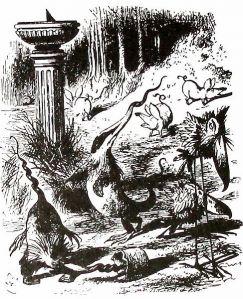
Slithy Toves Gyring
hereWikipedia
Parsons describes the work’s “logical non-sense” as a “semiotic catastrophe”, since the words create a discernible narrative within the structure of the poem, but we don’t accurately know what they symbolise. She argues that Humpty tries, after the recitation, to “ground” the unruly multiplicities of meaning with definitions, but he cannot succeed, as both the book and the poem are a playground for the “carnivalised aspect of language”. Parsons suggests that this is mirrored in the prosody of the poem: in the tussle between the tetrameter in the first three lines of each stanza and trimeter in the last lines, such that one undercuts the other and we are left off balance, like the poem’s hero.
I am uncertain what a semiotic catastrophe would look like, but I am nearly sure Carroll would be pleased with the description.
Jabberwocky
‘Twas brillig, and the slithy toves
Did gyre and gimble in the wabe;
All mimsy were the borogoves,
And the mome raths outgrabe.
“Beware the Jabberwock, my son!
The jaws that bite, the claws that catch!
Beware the Jubjub bird, and shun
The frumious Bandersnatch!”
He took his vorpal sword in hand:
Long time the manxome foe he sought –
So rested he by the Tumtum tree,
And stood awhile in thought.
And as in uffish thought he stood,
The Jabberwock, with eyes of flame,
Came whiffling through the tulgey wood,
And burbled as it came!
One, two! One, two! And through and through
The vorpal blade went snicker-snack!
He left it dead, and with its head
He went galumphing back.
“And hast thou slain the Jabberwock?
Come to my arms, my beamish boy!
O frabjous day! Callooh! Callay!”
He chortled in his joy.
‘Twas brillig, and the slithy toves
Did gyre and gimble in the wabe;
All mimsy were the borogoves,
And the mome raths outgrabe.
